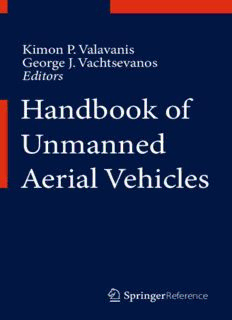
Handbook of Unmanned Aerial Vehicles PDF
Preview Handbook of Unmanned Aerial Vehicles
Kimon P. Valavanis George J. Vachtsevanos Editors Handbook of Unmanned Aerial Vehicles 1 3 Reference Handbook of Unmanned Aerial Vehicles Kimon P. Valavanis • George J. Vachtsevanos Editors Handbook of Unmanned Aerial Vehicles With1228Figuresand233Tables Editors KimonP.Valavanis GeorgeJ.Vachtsevanos JohnEvansProfessorandChair ProfessorEmeritus DepartmentofElectricalandComputer SchoolofElectricalandComputer Engineering Engineering DanielFelixRitchieSchoolof TheGeorgiaInstituteofTechnology EngineeringandComputerScience Atlanta,GA,USA UniversityofDenver Denver,CO,USA ISBN978-90-481-9706-4 ISBN978-90-481-9707-1(eBook) ISBN978-90-481-9708-8(printandelectronicbundle) DOI10.1007/978-90-481-9707-1 SpringerDordrechtHeidelbergNewYorkLondon LibraryofCongressControlNumber:2014944662 (cid:2)c SpringerScience+BusinessMediaDordrecht2015 Thisworkissubjecttocopyright.AllrightsarereservedbythePublisher,whetherthewhole or part of the material is concerned, specifically the rights of translation, reprinting, reuse ofillustrations,recitation,broadcasting,reproductiononmicrofilmsorinanyotherphysical way,andtransmissionorinformationstorageandretrieval,electronicadaptation,computer software, or by similar or dissimilar methodology now known or hereafter developed. Exempted from this legal reservation are brief excerpts in connection with reviews or scholarly analysis or material supplied specifically for the purpose of being entered and executedonacomputersystem,forexclusiveusebythepurchaserofthework.Duplication ofthispublicationor partsthereof ispermittedonlyunder theprovisions of theCopyright Lawof thePublisher’slocation,initscurrentversion, andpermissionforusemust always be obtained from Springer. Permissions for use may be obtained through RightsLink at the Copyright Clearance Center. Violations are liable to prosecution under the respective CopyrightLaw. Theuse of general descriptive names, registerednames, trademarks, servicemarks, etc.in thispublicationdoesnotimply,evenintheabsenceofaspecificstatement,thatsuchnames areexemptfromtherelevant protectivelawsandregulationsandthereforefreeforgeneral use. While the advice and information in this book are believed to be true and accurate at the date of publication, neither the authors nor the editors nor the publisher can accept any legalresponsibilityforanyerrorsoromissionsthatmaybemade.Thepublisher makesno warranty,expressorimplied,withrespecttothematerialcontainedherein. Printedonacid-freepaper SpringerispartofSpringerScience+BusinessMedia(www.springer.com) ToStellaandPanos,mychildren,andtoDina Kimon To mywifeAthenaandmygranddaughters Ellie,Athena,Sophiaand Martha George Foreword: Civil RPAS In European Union Airspace – The Road To Integration ByPetervanBlyenburgh President,UVSInternational1 Preamble The European remotely piloted aircraft systems (RPAS)2 industrial community consists of two stakeholder groups (Industry3 & SMEs/SMIs4, which both en- compass manufacturers and operators5. The civil RPAS market comprises three usergroups:commercial,non-commercial(incl.corporateoperations& research), and governmental non-military (state & non-state flights) operators (See Fig.1). Currently, the regulatory responsibilities in the European Union (EU) for civil remotelypiloted aircraft(RPA) with a maximumtake-off mass (MTOM)of more than150kglay withthe EuropeanAviationSafetyAgency(EASA),andforRPA with a MTOM of less than 150 kg with the relevant national aviation authorities (NAAs)6. Background Various initial national regulations relative to the operation of civil RPAS are now in place (Austria, Czech Rep., Denmark, France, Germany, Ireland, Italy, vii viii Foreword:CivilRPASInEuropeanUnionAirspace–TheRoadToIntegration RPAS Ops Governmental M Military U T U Non-Military State Flights Police N ALI Security related CBuosrdtoemr Gsuard ON Z Coast Guard A T Not State Flights Civil Protection M I Incl. Safety related Fire Fighters I O National Mapping Agencies L N I Non-Governmental Public European Union Flights on behalf of public EU agency T (without national oversight) A Commercial Air Transport Scheduled Air Service R (Transport of Persons & Freight) Non-scheduled Revenue Operations Y Non-revue Operations General Aviation Corporate Operations R Flight Training / Instruction P Pleasure A Aerial Work / Specialized Operations Commercial S Non-Commercial (incl. Corporate Operations) O Training / Instruction P Blyenburgh © Other Miscellaneous S Fig.1 AerialOperations-Current&Near-FutureRPASUsage Sweden,UK),areabouttoenterintoforce(Belgium,Finland,Lithuania,Norway, Switzerland), or are in preparation (Malta, The Netherlands, Spain) – See Fig.2. TheseregulationsprincipallyconcernLightRPAS7andtheyarenotharmonizedon a pan-Europeanlevel. The coming into force of these regulations, which is fairly recentinmostofthesecountries,hasbroughtaboutadynamicgrowthinapproved8 and authorized9 RPAS operatorssupplyingaerial operation services with an ever- growingdiversityofapplications10(SeeFig.3).Forreasonsofsimplicity,approved andauthorizedoperatorsarehereinafterjointlyreferredtoascertifiedoperators11. In fact, there are currently more than 1500 certified civil RPAS operators in the EuropeanUnion (See Fig.4). In practically all cases, currentflight operationsare takingplacewithinvisualline-of-sight(VLOS),ataflightaltitudeoflessthan500 ft above ground level (AGL) with RPA with a MTOM of less than 25 kg, which are principally produced and operated by SMIs. It should also be mentioned that a significant amount of European NAAs facilitate RPAS operations by granting Permits-to-Flyonacase-by-casebasis.TheEuropeanRPASindustrialcommunity nowhasasobjectivetoinitiateactivitiesthatwillmakeitpossibletostarttoenlarge thecurrentlypermittedflightenvelopes,andtooperatelargerRPAS. AgrowingnumberofgovernmentalauthoritiesinvariousEUcountriesinvolved withinternalsecuritymatters(e.g.municipal&nationalpolice,anti-terroristsquads, municipalfirebrigades,forestfirefighters,coastguard,civildefence,environmental protectionagencies), as well as FRONTEX (Europeanagency responsiblefor EU bordersecurity),havemanifestedgreatinterestintheuseofRPAS.Inaddition,large corporateentities (e.g. electric grid operators,pipeline network operators,railway operators,oilcompanies)havewokenuptothefactthatRPAScouldfulfilfunctions that would be extremely beneficial to their corporate operations. However, in all casestheuseofRPASwilldependontheacceptabilityoftheproposedRPASflight hourcost. Foreword:CivilRPASInEuropeanUnionAirspace–TheRoadToIntegration ix In MTOM In place MTOM Comments Preparation 01 Austria F < 150 kg VLOS 02 Belgium F < 150 kg VLOS Finalised (2013) but not in force 03 Bulgaria 04 Croatia 05 Cyprus 06 Czech Rep. F < 150 kg VLOS BLOS In place (May 2013) 07 Denmark F < 150 kg VLOS In place (Jan. 2004) 08 Estonia 09 Finland F < 150 kg VLOS Expected mid 2014 10 France F < 25 kg VLOS BLOS < 150 kg VLOS BLOS In place (Apr. ‘12) To be update in 2014 11 Germany < 25 kg VLOS In place (2013) 12 Greece F 13 Hungary F < 150 kg VLOS 14 Ireland F < 20 kg VLOS In place May 2012) 15 Italy F < 25 kg VLOS In place (Dec. 2013) 16 Latvia 17 Lithuania F < 25 kg VLOS < 150 kg VLOS Expected mid 2014 18 Luxembourg 19 Malta F < 150 kg VLOS In preparation 20 Netherlands F < 25 kg VLOS < 150 kg VLOS In place (2012) Update in preparation 21 Poland F < 150 kg VLOS BLOS In place 2013 22 Portugal 23 Romania F 24 Slovakia 25 Slovenia F 26 Spain F < 25 kg VLOS In preparation 27 Sweden F < 150 kg VLOS In place (Mar. 2013) 28 UK F < 20 kg VLOS In place (2002) Several updatessince Sub-Total 12 3 8 1 29 Iceland < 150 kg VLOS BLOS 30 Norway F Expected mid 2014 31 Switzerland F Model aircraft rules apply VLOS over people/ Directive expected crowds 2014 Sub-Total 1 2 Total 12 3 9 2 F RPAS aerial operations facilitated = Permit to Fly is granted by NAA, based on specific national rules, possibly on a case-to-case basis & for a limited duration (incl. in countries where no national regulation exists). © Blyenburgh Fig.2 RPASRegulationinEurope
Description: